Just three months after Verizon launched the Droid 3 last July, buyer's remorse set in: the Droid 4 would add a speedy Verizon LTE connection, a edge-lit keyboard and a slick RAZR-like design, it seemed, long before owners of the existing handset would see their two-year contract end.
Well, the Droid 4 took its sweet time getting here, but the phone is on sale this week, and as of today it's the only dual-core LTE smartphone with a physical QWERTY keyboard you'll find in the United States. If you need to touch-type on your cellular handset, churn through multithreaded apps, and browse the web at LTE speeds, the Droid 4 is the only game in town. But is it a good handset, period? Read on to find out.
Video Review
The Droid 4 is a straight mashup of the Droid RAZR and Droid 3, no question there: put the three handsets on a table and you'll see connections everywhere. The Droid 4 has the same beveled edges and camera module placement as the RAZR, even as familiar Droid 3 components jut out of every edge, including the same neatly cloven volume rocker on the right, annoyingly shallow power button at top center, and Micro USB / Micro HDMI combination at the bottom left hand corner. There's still no physical camera button, a bit of a shame there. The only real departure from existing phones is around back: instead of the smooth Kevlar or silky soft-touch plastic gracing previous handsets, Motorola's added a slightly harder rubber with a textured finish. All in all, I'm pretty pleased with the new style and ergonomics, because the Droid 3 was an ugly tank of a utilitarian device, and while the Droid 4 isn't any easier to stuff in a pocket (it's practically the exact same size) the grip feels quite nice. With medium-sized or larger hands, your fingers can grasp right around those beveled edges and rubber curves to keep the phone secure, though there is one disadvantage: you have to be careful not to let the Droid jump out of your hands when sliding open the hinge. I've spent years opening sliders with one hand, but here it's safer to use two and I'd recommend that here.
Three hinge-related drops occurred during the course of this review
Speaking of that hinge, it's also the same design as on the Droid 3, though perhaps a bit stiffer; it's not the best I've seen, with a little bit of play in each direction, but it is better concealed this time around. Like all previous Droids, you slide open the screen on a pair of rails on either end with your thumbs doing the work, as there's no spring to push it along, although there are a set of springy tabs that hold it open and closed. Those tabs are stiffer than usual here, so out of all the Droid sliders, this one's also the least likely to open in your pocket or close inadvertently.
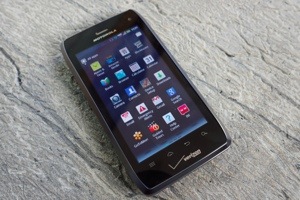

Keyboard
Motorola tried to fix what wasn't broke, but it's still a great keyboard
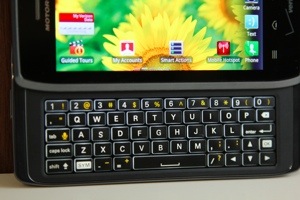
If you're seriously considering a Droid 4, the keyboard is probably why, and the five-row QWERTY layout here doesn't disappoint. At the risk of sounding like a broken record, it's exactly the same set of comfortably spaced little squares as on the Droid 3, except now they fully light up in the dark and the layout has changed slightly. If you ask me, though, the laser-cut edge-lit keys are actually a bit too bright for typing in dark rooms now.
The layout changes are hit and miss, too. It's nice that symbols are now matched to the number keys just like they are on traditional PC keyboards, but Motorola's shoved the Shift key down, and replaced the search, voice search and ALT keys with more symbols and a new Caps Lock button. While I'll probably get used to the layout, it's a little disconcerting to press Caps Lock when you think you're hitting Shift as I've done many a time so far, and the lack of search and ALT buttons means you can't use keyboard shortcuts to quickly go to the beginning or end of a line of text or switch between apps. It feels like the intent was to make the keyboard look less cluttered, but Motorola wound up making it slightly less useful, too.
Display
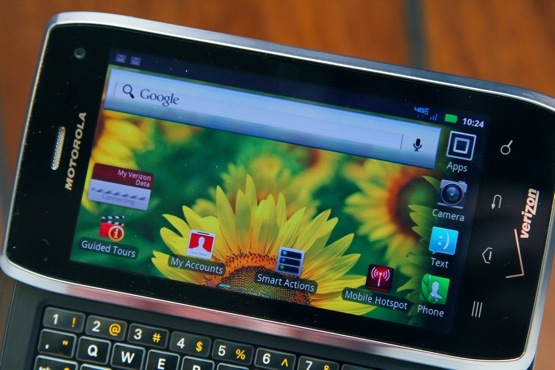
The Droid 4's four-inch qHD (960 x 540) LCD display uses a PenTile matrix, just like the Droid 3, and that means that even though it's reasonably clear and gets nice and bright, images aren't quite as fine or detailed as you'd expect from the supposed 275ppi pixel density. My old Droid 2's 3.7-inch, 854 x 480 screen shows me much crisper icons and fonts. That's not the only issue, either, as the display tends to wash out quickly when viewed from off-angles, and there's very noticeable ghosting as you swipe and scroll. It's sub-par, but especially now that lovely AMOLED screens and or 720p resolution are becoming the superphone norm, the Droid 4's LCD display feels pretty terrible. If you don't need a keyboard, you'd be far better off with the 720p screen on the excellent $199 HTC Rezound, and of course there's the iPhone 4S and Galaxy Nexus to consider as well.
If you care about display quality, PenTile is not what you want
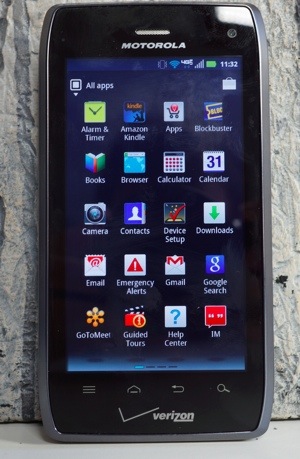
Software
Welcome to Bloat City
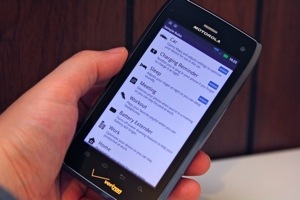

If you want to know just how obtrusive (and yet occasionally useful) Motorola's software skin has become, look no further than our Droid RAZR review: near as we can tell, it's the same UI layer atop the same Android 2.3.6, and Motorola's similarly promising an upgrade to Android 4.0 in the future without specifying when it might relieve us from software limbo. While we're still not fans of the way the Blur UI behaves on the whole, it's definitely got its perks: in particular, I enjoy how easy it is to manage icons on the five available homescreens, and the camera app's a good bit better than the one in stock Gingerbread as well. The ability to jump into the camera directly from the lock screen is also a plus.
Verizon and Motorola also have a truly astounding selection of pre-installed apps and bloatware on board (for example, a video advertisement for Slingbox made the cut), and while I won't name them all, suffice it to say you'll want to spend some time cleaning house. If your experience is anything like mine, though, a number of the items you'll most want to uninstall (like that Slingbox ad) simply won't be removable. There are some worthy programs like QuickOffice, MotoPrint, and Netflix, though, and Motorola's Smart Actions app is the exception to the general rule: it lets you tell the phone to automatically adjust its settings under certain conditions (like lowering the volume of your alarm at night) and it can be truly useful. The Droid 4 also supports Motorola's Webtop application if you've got a compatible dock, but we've never found it to be worth the trouble.
Performance and battery life
The Droid 4 has the same dual-core 1.2GHz TI OMAP 4430 chip with PowerVR SGX 540 graphics you'll find in most every high-end Motorola smartphone on the market today, including the Droid 3 (though it's clocked 200MHz slower there), and as far as speed is concerned it's more than a match for Android 2.3 and most anything you'd care to run on the operating system as today. Paired with 1GB of RAM, double that of its predecessor, the phone notched scores of 2500 in the general-purpose Quadrant benchmark and 2211ms in the SunSpider browser test, both quite good though about par for the course for these specs. Shadowgun and Grand Theft Auto III were both quite playable.
Verizon LTE
Verizon LTE performance has been a little spotty in the San Francisco Bay Area, so my results were all over the place, but speeds were pretty great nonetheless: I got anywhere from 6Mbps download and 3Mbps upload speeds all the way to 25Mbps down and 19Mbps up when the network felt like giving it to me. In reality, the extra speed came in handy all the time, with web pages often completely loaded by the time the browser finished rendering, the ability to zoom in on Google Maps satellite images without a delay, and push email that literally arrived over ten seconds before it hit my 3G devices, every single time.
LTE is the only way to fly... unless you care about sustained battery life
Of course, as we've seen time and again, the Achilles' heel of a speedy LTE connection is substantially reduced battery life. I took a Droid 4 from 100 percent charge down to 20 percent with four hours of heavy use (GPS navigation, gaming, downloading and installing apps) and drained it dry three hours of casual use after that. On our Verge Battery Test, which loops a series of 100 popular websites and high-res images with the phone set to 65 percent brightness, the Droid 4 lasted only three hours and 56 minutes before giving up the ghost.
Interestingly, though, it's only active usage that drains the battery that quickly and the phone actually holds a charge pretty well: just sitting on my desk, receiving push email, a second Droid 4 lasted over two days on a charge.
You'll want an extra charger at work if you're a heavy user, for sure, but if you forget to plug the Droid 4 in at night you won't necessarily find it dead in the morning like some other phones. Don't count on swapping batteries, though: for some inexplicable reason, you'll need a pin and a Torx T-5 screwdriver to remove the cover and pull it out, and you'll also be voiding your warranty to do so. Interestingly, there's also a set of four golden pins beneath the cover which don't connect to anything yet: they're probably just for the inductive charging kit, but it'd be neat if case manufacturers figure out a way to build an external battery instead.



GPS and call quality
Speaking of Google Maps, I was pretty impressed with the Droid 4's GPS performance as well. In a pair of simulated commutes, it locked onto satellites and updated my position more quickly and accurately than many phones I've used.
Last but not least, there are a pair of microphones on the Droid 4 for noise cancellation at top and bottom, and callers told me I sounded pretty clear: even in front of a running faucet, they could hear me speak. I can't say I had always the easiest time hearing them clearly through the phone's earpiece, though some conversations were indeed clear. That's something you might want to test for yourself before buying.
By the way, Verizon's promised that the Droid 4 will have global GSM roaming capabilities at some point later this year.


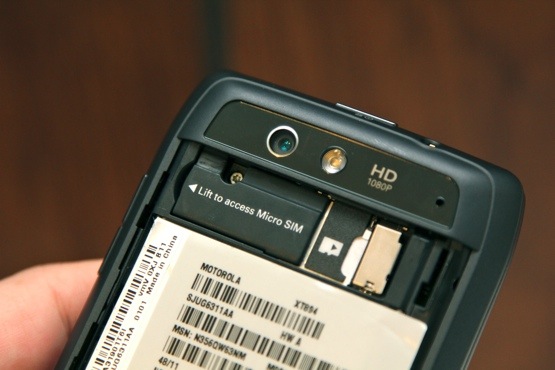
I can't think of a single Motorola phone I've ever used with a good camera, but the Droid 4's 8-megapixel imager isn't bad: like the one on all the company's recent top-tier smartphones, it takes pretty decent shots in good light and with very little shutter lag, along with 1080p video that does indeed look like it was filmed at that resolution. Low light or motion brings out the worst in the camera, though: expect plenty of noise in your images and a jelly effect in your videos in any but the most perfect scenarios. There's also a 1.3-megapixel front-facing sensor for video calls, but if the few disgustingly noisy yellow-tinted images I got from it are the norm, it's pretty awful.
There's no two ways about it: the Droid 4 is flawed
There's no two ways about it: the Droid 4 is flawed. If you buy one, you'll be settling for a device without the best screen, the best battery, the best camera, or the best software on the market. I'd even argue that it doesn't have the best keyboard, as the Droid 3's layout made more sense. And yet, despite all that, this phone is still pretty attractive to the right buyer. I wish Motorola had put a little more effort into making the Droid 4 the best phone it could possibly be: a truly top-tier handset instead of the second-class citizen that phones with physical keyboards have become. Still, on most every count, the Droid 4 is good enough for the job. It's pretty simple, really: if you truly need a good QWERTY keyboard, a dual-core processor and LTE, it's your only choice right now. I do. I bought one. We'll see how things work out.
David Pierce contributed to this review.
:format(webp)/cdn.vox-cdn.com/uploads/chorus_asset/file/12790343/droid-4-main-1020-stock-2.1419965159.jpg)
:format(webp)/cdn.vox-cdn.com/uploads/chorus_asset/file/12790343/droid-4-main-1020-stock-2.1419965159.jpg)
Share this story